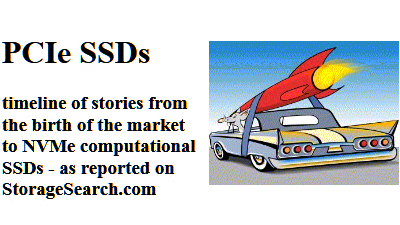|
by Zsolt Kerekes,
editor - StorageSearch.com
- December 21, 2012 |
This article looks
over some of the many strategic transitions in the SSD market during
the past year
(2012). |
|
Strategic Transitions in SSD - the short version
- most significant new SSD product type -
2.5" PCIe SSDs
Advanced
products and propotypes were shown by several leading SSD companies in 2012.
The new form factor will significantly impinge on the established
markets for PCIe SSDs,
SAS SSDs and
rackmount SSDs
and creates new opportunities for vendors to establish leadership and
differentiation.
- most significant emerging technology -
adaptive R/W
DSP flash management.
Although this technology has been around for
over 2 years - 2012 was the first time that the number of SSD makers using
adaptive DSP hit double digits.
This was a fact which surprised many
of the leading companies withn this technology segment when I told them they
weren't as alone as they had imagined at the start of this year.
- most searched for (and most researched - by analysts) SSD company -
Fusion-io
On
the plus side - in 2012 FIO demonstrated an uncanny management ability to
anticipate, digest and react to the many competing business and technology
forces which touched on the company's activities within the enterprise SSD
market - which Fusion-io demonstrated by achieving year on year revenue
growth rates very close to the exact numbers which the company had offered as
guidance in the year before.
But still unknown (at the time of
publishing this) is FIO's public response to adaptive R/W technology.
When I published a
SWOT risk assessment
of adaptive R/W for leading SSD companies in July 2012 - Fusion-io told me
it didn't want to reveal what its exact strategy for adopting this technology
would be.
FIO wasn't the only company to decline revealing its future
plans about this detailed level of technology and its reticence is
understandable.
SSD analysts like
me (and competitors) can infer a lot about future product directions, the
likely product mix and even the probable timing of new SSD models from
simply knowing that a company in the fast SSD segment has serious thoughts
about using adaptive R/W. Nevertheless - the assumptions I made in my article
analyzed the probable options. For longer versions of what happened
in the SSD market in 2012 - take a look at these resources:-
- SSD Buyers
Guide - includes a rolling summary of key market milestones in the SSD
market in the past year
- Storage
market history - aka archived news - has more stories and more detail -
although depending when you read this article - some of it may still be in the
live SSD news.
What will you be reading more about in the SSD
news pages in 2013?
- acquisitions
- there already have been a lot. There will be a lot more.
- ratios
- the ideal ratios of different types of SSD storage in user environments will
become clearer.
This will help users manage their budgets and provide
pragmatic comparison points for deciding if the solutions they're being offered
are technically appropriate for their needs and offer good value.
Users
will evolve their own rules for what proportion of SSDs in different speed
ranges give them good results in a way they can sustainably afford.
We''ll
also learn more also about the ratio of different types of memory being
supplied to the SSD market - and learn to spot the danger signs of looming
obsolescence in memory types.
- efficiency
- is a high level comparison metric which can tell you a lot about how well
all the parts of an SSD design work together.
When you learn that
SSD-X can be used in exactly the same application role as the competing SSD-Y
while using 30% less flash chips - for example - you feel you know something
useful about comparing these SSDs - even without having to get into the
difficult technology details. You also know something useful about their
business prospects too.
- reliability -
vendor claims about SSD reliability will branch out into different directions.
Do you really care if the
endurance of SSD-X is 20x
better than some older way of managing flash?
Do some ways of
managing high
availability in SSD racks sound much safer to you than others?
Or
do you prefer your own way of assessing and managing SSD reliability because
it takes into account risks and consequences which are more relevant to you
than than generalist approaches?
Strategic Transitions in SSD - the slightly longer versionThe
SSD market in 2012 had all the symptoms of a market which was confidently
growing and on its way towards much bigger and better things.
One
sign of this was that new companies were unafraid to abandon heavily fought
for positions (such as the established credibility of particular memory types
and controller architectures). We learned about new ways to reset - what we
thought had been - intrinsic hard-wired limits on flash speed, power
consumption, reliability, density and cost.
So any idea that the pace
of change might slow down and settle into some kind of cosy
consolidation
is still many years into the future.
"SSD" means "flash"
When
people talk about SSDs - the memory type they're talking about is nearly
always nand flash.
RAM SSDs have shrunk to
become less than 2% of total shipped SSD capacity. While
RAM caches in flash
SSDs average out even smaller than that.
Meanwhile - despite over
a decade of talk about flash
killer non volatile memory alternatives - my analysis is that such memories
would do well to reach even as high as single digit percentage market share
within SSDs in the next 3 years.
a note on flash diversity
In
addition to all the usual types of flash memory (which I won't bother listing
here - but as you know all
their names all
end in "LC") here's a new flash type to think about.
this
exact same flash memory is significantly different (in speed and reliability)
to this exact same flash memory in these cases
- same controller - but different preconditioned program times
- different type of controller - classical versus adaptive
- different type of controller - adaptive optimized for market A versus
adaptive optimized for market B
Many permutations of desirable
characteristics are possible - which manipulate speed, power consumption,
efficiency and reliability.
A safe rule of thumb is that knowing the
generic memory type characteristics doesn't give you enough useful info about
the SSD's
characteristics and limitations any more. Whereas only a few years ago -
knowing the exact memory type was an essential starting point in understanding
the SSD.
The top SSD companies in 2012
If we look at
the top 5 SSD companies that people were reading about and researching during
2012 - there was a hard core of 4 companies which stayed in the list for all 4
quarters.
- Violin and
STEC - each having been
at #2 or #3 for 1 or more quarters
- OCZ - mostly at the #4
position
In the already published editions of the
top SSD companies list
(for Q1, Q2 and Q3 2012) - both
LSI and
Texas Memory Systems
have put in appearances within the top 5 companies.
However, it now
looks almost certain that in the Q4 2012 edition of the list - which will be
published in mid January 2013 - there will be 2 new companies in the top 6 range
which have never previously had such high listings before.
This
demonstrates that even within an SSD market numbering over 400 active companies
- there's still sufficient elasticity in the minds of SSD decision makers to
make significant new accomodations in their thinking for a few new SSD brands -
even at the top end.
enterprise SSD market
Surviving
and triving in the enterprise SSD market has become very challenging - with
yesterday's hard won "conventional wisdom" becoming tomorrow's
must-forget because it's now obsolete idea. I listed defensive strategies in a
survivor's
guide.
How many distinctly different types of SSDs do users need
to satisfy all future projected requirement?
The exact number depends
on how big and diverse the apps are and the market you're in.
For
most organizations the answer is more than 1 type and the maximum (assuming
you're the US government) is 7.
What they are - and how they relate to
each other is described in
an introduction to
enterprise SSD silos.
SSD software
The current
state of the SSD software is not at all what you'd expect if you had any
previous experience of traditional computer markets. I explained
the reasons why
in an article.
If you haven't yet acquired an
SSD company - there
are some still left. I warn a bunch of readers last year that owning an SSD
company would become less of a competitive differentiator when it became the
norm.
If you do a good job virtualizing the SSD - and SSDs become the
computer - then a small number of top SSD software solutions have the potential
to become the gateway to everything that will be important in computing - even
more important than the choice of SSD hardware, OS or CPU type.
In
the long term future most of the critical systems code in an apps server will
be about the SSD. This very serious idea was explored in a spoof
article - Fusion-io
acquires Microsoft's server business
industrial SSDs
Within
a few shrink generations - SLC will present exactly the same data state
discrimination problems which MLC controller designers met years ago. If you
need an MLC type of controller to manage this - it will mean that future
generations of SLC have no reason to exist.
Another reason SLC might
cease to be commercially available might be that it will become such as small
part of the memory mix that high volume memory makers don't find it worthwhile
producing any more.
These are some of the memory roadmap realities for
industrial SSD
makers.
military SSDs
The economics and logistics
of true military SSDs are different. Even if standard memory makers stop making
SLC - feasible options for mil SSD makers will be - stockpiling or setting up a
low volume military market focused fab to continue making large geometry SLC -
until something better (in hard nvm terms) comes along.
consumer
SSDs
Users in other markets have been technically clever enough to
deploy new SSDs despite not having everything already neatly laid out for them -
or have had sufficient cost / benefit inventives to adapt and integrate the SSD
they like with the software they like.
Not so - with the consumer - who
ever since the notebook SSD market started in 2006 - has been offered SSD based
solutions such as notebooks and tablets which fall a long way short of what they
should reasonable expect - partly because of the bad state of the SSD software
market - but mostly because of too much HDD thinking behind most notebook SSDs.
In
the past year or so we have seen the emergence of SSD based notbooks which are
acceptable. But there's still a lot of headroom available in terms of what this
type of product should do and what it should cost.
The industry has
blamed the low take up of SSD notebooks on cost - but the real culprit was badly
designed products.
One impact of the consumerization of the cloud - is
that the capacity in the notebook doesn't define how many videos you can watch
or how much music you can hear.
That factor could speed up SSD adoption
and render the higher capacities of hard drives irrelevant for a significant
proportion of the market.
conclusion
As the SSD market
gets bigger - the incentive for clever minds to focus on its roadblocks and
problems has grown too.
Despite all the changes we've seen in 2012 -
I'm confident that in future years we'll look back and say - 2012 was a quiet
year compared to what's going on now.
Happy Holidays | | |
| . |
It looks like you're seriously interested
in SSDs. So please bookmark StorageSearch.com and come back again soon.
Also
- if you've got the time - you might want to take a look at
the top 100 most
popular SSD articles seen by our readers in the last month or so. |
| . |
 |
| |
.... |
 |
| .. |
|
|
.. |
 |
.. |
|
|
.. |
 |
..... |
|
|
. |
 |
. |
| "One of the most
potentially most rewarding market challenges which SSD companies are grappling
with right now is - how to make enterprise solid state storage attractive to
users who aren't worried about their hard drive performance and don't even think
they need SSDs." |
| exciting new
directions in rackmount SSDs (May 2013) | | |
.
. |
|
|
.
.
. |
|
|
.
.
. |
 | |










